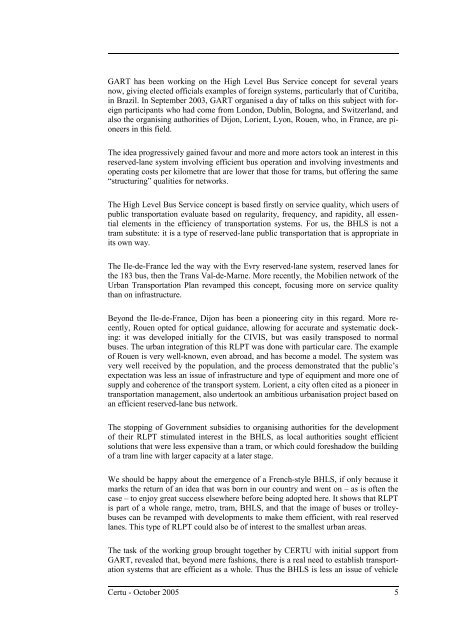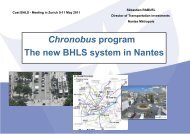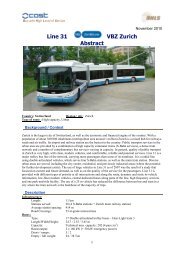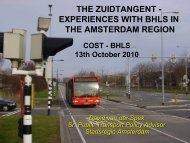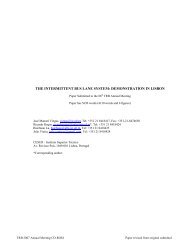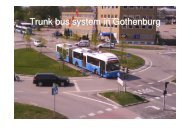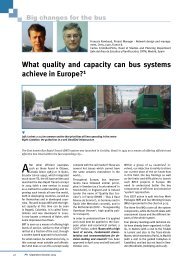BHLS_englishVersion_..
BHLS_englishVersion_..
BHLS_englishVersion_..
You also want an ePaper? Increase the reach of your titles
YUMPU automatically turns print PDFs into web optimized ePapers that Google loves.
GART has been working on the High Level Bus Service concept for several years<br />
now, giving elected officials examples of foreign systems, particularly that of Curitiba,<br />
in Brazil. In September 2003, GART organised a day of talks on this subject with foreign<br />
participants who had come from London, Dublin, Bologna, and Switzerland, and<br />
also the organising authorities of Dijon, Lorient, Lyon, Rouen, who, in France, are pioneers<br />
in this field.<br />
The idea progressively gained favour and more and more actors took an interest in this<br />
reserved-lane system involving efficient bus operation and involving investments and<br />
operating costs per kilometre that are lower that those for trams, but offering the same<br />
“structuring” qualities for networks.<br />
The High Level Bus Service concept is based firstly on service quality, which users of<br />
public transportation evaluate based on regularity, frequency, and rapidity, all essential<br />
elements in the efficiency of transportation systems. For us, the <strong>BHLS</strong> is not a<br />
tram substitute: it is a type of reserved-lane public transportation that is appropriate in<br />
its own way.<br />
The Ile-de-France led the way with the Evry reserved-lane system, reserved lanes for<br />
the 183 bus, then the Trans Val-de-Marne. More recently, the Mobilien network of the<br />
Urban Transportation Plan revamped this concept, focusing more on service quality<br />
than on infrastructure.<br />
Beyond the Ile-de-France, Dijon has been a pioneering city in this regard. More recently,<br />
Rouen opted for optical guidance, allowing for accurate and systematic docking:<br />
it was developed initially for the CIVIS, but was easily transposed to normal<br />
buses. The urban integration of this RLPT was done with particular care. The example<br />
of Rouen is very well-known, even abroad, and has become a model. The system was<br />
very well received by the population, and the process demonstrated that the public’s<br />
expectation was less an issue of infrastructure and type of equipment and more one of<br />
supply and coherence of the transport system. Lorient, a city often cited as a pioneer in<br />
transportation management, also undertook an ambitious urbanisation project based on<br />
an efficient reserved-lane bus network.<br />
The stopping of Government subsidies to organising authorities for the development<br />
of their RLPT stimulated interest in the <strong>BHLS</strong>, as local authorities sought efficient<br />
solutions that were less expensive than a tram, or which could foreshadow the building<br />
of a tram line with larger capacity at a later stage.<br />
We should be happy about the emergence of a French-style <strong>BHLS</strong>, if only because it<br />
marks the return of an idea that was born in our country and went on – as is often the<br />
case – to enjoy great success elsewhere before being adopted here. It shows that RLPT<br />
is part of a whole range, metro, tram, <strong>BHLS</strong>, and that the image of buses or trolleybuses<br />
can be revamped with developments to make them efficient, with real reserved<br />
lanes. This type of RLPT could also be of interest to the smallest urban areas.<br />
The task of the working group brought together by CERTU with initial support from<br />
GART, revealed that, beyond mere fashions, there is a real need to establish transportation<br />
systems that are efficient as a whole. Thus the <strong>BHLS</strong> is less an issue of vehicle<br />
Certu - October 2005 5


